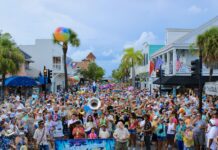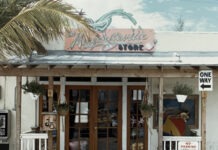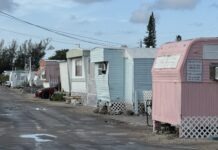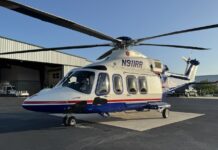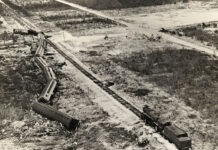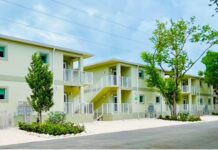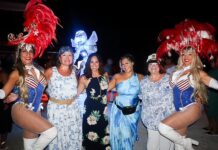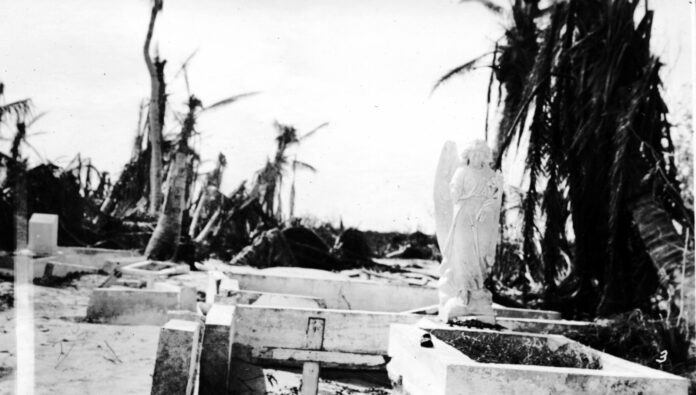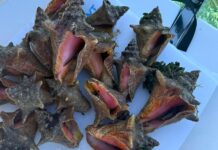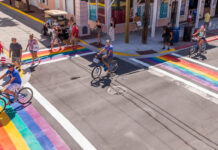When Islamorada developed, it was a railroad town. People like to say otherwise.
They tell stories about Spanish conquistadors sailing past and declaring Islamorada the Purple Isles. How the color purple was chosen depends on who is telling the story. Sometimes, the inspirational hue comes from the water, bougainvillea bracts, or Janthina janthina, commonly called the violet sea snail.
There are other variations of the colorful story. According to the man who created the name, none is true. He was William Krome. Henry Flagler hired him to survey the right-of-way down which the train would rock and roll from the mainland to Key West. The work introduced Krome to Upper Matecumbe Key, and apparently, he liked what he saw. Mr. Krome purchased 15 acres of the island from John H. and James W. Russell for $735.
The Russell family arrived in the 1850s. They were the first to make a homestead claim on the island. When the 1870 U.S. Census was taken, four houses and 13 people were documented on Upper Matecumbe. Joseph and Mary Saunders lived in one house. The extended Russell family lived in the other three. James W. Russell was 26, and John H. was 12.
Mr. Krome surveyed his newly acquired property and subdivided it into 22 lots. He built a house for himself and one for his father. Krome also registered the land and named the new town site Isla Morada. According to an interview with Isabelle Krome, his wife, she said, “I was not a member of the family at that time and had no part in the selecting of the name, but Mr. Krome told me that it was derived from the Spanish isla and morada, meaning home.”
A newspaper clipping dated May 7, 1907, announced: “On the north end of Upper Matecumbe Key, a new town known as Isla Morada has sprung into existence. … It is believed that Isla Morada will become an important tourist stopping place in winter as the location is beautiful and the fishing convenient and excellent.”
Decades later, the Islamorada Chamber of Commerce chose “Sport Fishing Capital of the World” as the community’s official motto. Also, Islamorada remains “an important tourist stopping place.” However, the town has grown a little since Mr. Krome brought it into existence. Islamorada no longer represents a small town on Upper Matecumbe Key but a village of islands that includes Plantation Key, Windley Key, Upper Matecumbe Key and Lower Matecumbe Key.
Driving across the heart of Islamorada, Upper Matecumbe Key, expect history, art and cold, locally brewed beer.
One of the seminal events in Florida Keys history is the Category 5 hurricane of Labor Day 1935. This is especially true of Islamorada. The storm remains the most powerful hurricane ever to make a North American landfall. It also marked the end of Henry Flagler’s Over-Sea Railroad.
After heading west past the green and white MM 83 sign, the Islamorada Post Office will appear on the left. It sits at the corner of the Overseas Highway and De Leon Avenue. In terms of local history, this is a much bigger dot on the map than it might first appear. When the train was still running, this was the general area where the Islamorada Station once stood. On the other side of the tracks was Mr. Krome’s original 15-acre Islamorada town site.
On the day of the hurricane, the train made its last run from the mainland and stopped at the Islamorada Station minutes before 18 feet of storm surge washed over the island and pushed the train’s cars off the tracks and on their sides. The devastation to the community was unimaginable. Just a little bit down the road is the Florida Keys Memorial, locally known as the Hurricane Monument. It stands near MM 81.7 and honors the hundreds of people lost in the killer storm. The monument’s obelisk stands 18 feet tall, about the height of the storm surge that washed across the Matecumbe Keys. The crypt at the base of the obelisk is topped with a mosaic of the island chain and shows the islands most affected by the hurricane. Inside the crypt are ashes from the storm’s victims.
The monument also marks the general location of the original Upper Matecumbe community called, simply, Matecumbe. The “heart” of Matecumbe beat at what is today the Cheeca Lodge. The property housing the resort was home to Matecumbe’s pioneer church, school and cemetery. While the hurricane destroyed the church and the grammar school, the cemetery remains.
Like Tavernier, Upper Matecumbe Key is home to a concentration of historic buildings.
There is not a single structure on the island predating the 1935 Labor Day Hurricane. However, many of the structures built after the storm still stand.
On Jan. 2, 1936, a Key West newspaper published a story discussing a series of proposed storm structures to be built, “hurricane-proof community houses along the lower east coast and in the Lake Okeechobee and the keys region. The building will be of sufficient size to house the entire population in the area served by each. They will be used for school, church and general civic purposes and during the hurricane season will be used as houses of refuge in which people of the area may escape the dangers of high wind and water.”
What is now the Islamorada library was one of these buildings. Originally the Matecumbe Grammar School, found on the other side of the highway from the monument, it was built with 12-inch concrete walls reinforced with rebar to withstand the force of a major hurricane. The elevated foundation helped to mitigate flooding. Additionally, the structure included a cistern to hold fresh water. Single-family houses, 28 of them, were also constructed in this fashion and are known as Red Cross or Hurricane Houses.
The houses were donated, with the only stipulation being that the family had to own the property on which the house was built. Many were constructed for surviving members of the Matecumbe community. One of these historic buildings is currently home to the Islamorada Art Gallery. The local artist known as Pasta displays his marine fine art in the old Red Cross house. Step inside to see some great local art and step back in time. Afterward, stop by the Florida Keys Brewing Company for some fresh and tasty local beer before strolling through the Morada Way Art District.
